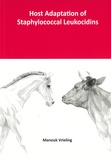Host adaptation of Staphylococcal Leukocidins
Summary
Staphylococcus aureus is a common human and animal pathogen and has risen as a major global health threat due to the emergence of antibiotic resistant clones and the failure of successful vaccine development. The pathogenicity of S. aureus is linked to its ability to secrete a large amount of virulence factors, amongst which secreted toxins play a preeminent role. The bicomponent pore forming toxins, also known as leukocidins or leukotoxins, are secreted toxins capable of killing a broad range of myeloid cells. Strikingly, leukocidins display a distinctive species specificity, differentially targeting certain cell subsets in disparate species. Importantly, some of these leukocidins are located on prophages which contribute to the spread of virulence factors through different lineages of S. aureus, thereby potentially mediating host adaptation. This thesis explores the molecular basis of species specificity of the staphylococcal leukocidins and investigates their potential as intervention targets in a relevant natural host (cattle).
The bicomponent leukocidin LukMF’ is phage-encoded and exclusively harbored by S. aureus of ruminant origin. LukMF’ has been associated with bovine mastitis in epidemiological studies and is thought to be involved in the pathogenesis of mastitis because of its lytic effect on bovine neutrophils, the most important effector cells in preventing intramammary infections. In Chapter 2, we identified CCR1 as the major host receptor of LukMF’, explaining the profound susceptibility of bovine neutrophils to this toxin. In addition to LukMF’, bovine mastitis isolates harbor four other leukocidins that potentially target and kill phagocytes. In Chapter 3, we investigated the role of these leukocidins and LukMF’ in the pathogenesis of bovine S. aureus mastitis in vitro and in vivo. In this chapter, we showed that LukMF’ is the most potent secreted toxin of bovine S. aureus and that LukMF’-secretion is associated with the clinical severity of mastitis. Therefore, we hypothesized that an intervention strategy aimed at neutralizing LukMF’ cytotoxicity would be valuable to control disease. Accordingly, in Chapter 4, we explored the potential of LukMF’ as a vaccine target for bovine mastitis and found that vaccination is a promising strategy to neutralize leukocidin cytotoxicity. Chapter 5 describes the discovery of a novel phage-encoded leukocidin, LukPQ, associated with equid strains of S. aureus. We identified the molecular targets and species specificity of LukPQ and gained novel insights into the molecular mechanism of leukocidin species specificity. Finally, we discuss the role of the staphylococcal leukocidins in the adaptation of S. aureus to different hosts and the implication of these findings to control staphylococcal diseases in humans and animals in Chapter 6.
